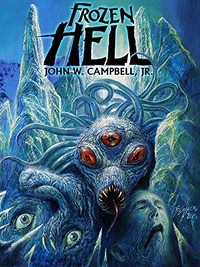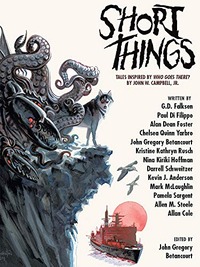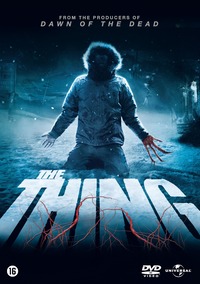At some point in the recent past I was struck with an urge to read Who Goes There?, the John W. Campbell novella that inspired one of my favourite movies, The Thing. I can’t recall where that urge came from—maybe it was nothing more than a desire to read something new and yet also familiar—but it was suddenly very important that I read it. Unfortunately it turned out that I did not, in fact, own a copy of Who Goes There? nor could I find a sufficiently cheap copy online that would arrive quick enough to scratch the itch.
What I did have, I soon remembered, was an ebook of Frozen Hell, the original version of Campbell’s novella which I had picked up through Kickstarter several years earlier. This version had been discovered among Campbell’s papers some years after his death. By all accounts it is largely the same as the eventual published version, the inclusion of three introductory chapters being the major difference from the novella.
Reading this triggered something of a descent into a rabbit hole during which I read almost everything Thing-related that I could get my hands on and—because this is how things work—my thoughts on all of them are below!
Frozen Hell

You can read more about the backstory to this version of Campbell’s novel here. My completism doesn’t quite extend to needing to read the published version as well, so I consider it to be an acceptable substitute for Who Goes There? By all accounts it’s essentially the same piece of work: just a little longer and lacking a handful of edits.
It was an interesting experience reading something hailing from the ‘Golden Age’ of American science fiction and I came away with two main thoughts:
- People really don’t write like this anymore (duh), and that’s not necessarily a bad thing.
- Given the huge stylistic differences, there is a surprising amount of commonality with John Carpenter’s movie here.
On the first point this is really about the way that narrative styles have evolved over the last hundred years or so, veering away from a sense of artifice and drama towards something more naturalistic. Campbell’s characters are, nevertheless, very human—they react in predictable ways to the fact that there’s a creature among them that might not only kill them but destroy the entire world—but there were still moments that I found odd. Characters would often laugh or giggle, which seemed jarring given the situation they’re in. At other times they would come across as almost too blase.
Furthermore, while Campbell’s descriptive writing is superb, there was an awful lot of talking—and I’m talking primarily about expository dialogue here. Despite the brevity of the tale, and the leanness of the plot, the narrative is very dense and I had the sense of having to wade through it to get to the end even though this is really a very short and enjoyable read.
Given the above, it was a pleasant surprise to discover quite how much Bill Lancaster had taken from the original novella when writing his screenplay for Carpenter’s adaptation. I’m not going to go into spoiler territory here, but a lot of the tentpoles are already in place—the blood test; the doctor going insane; the shape-changing. While Lancaster undeniably used Campbell’s blueprint and turned it into something fresh and new, it’s immediately clear that he took far more than just the basic concept from the novella.
The Adaptations
I’m not going to talk much about the 1982 version of The Thing; partly because there’s already so much written about it out there, but also because it’s such a part of my cinephile DNA that I’m not sure I can say anything objective about it at this point.

What I can talk about instead is the Howard Hawks 1951 movie The Thing From Another World (which I will note was directed by Christian Nyby, but almost everyone considers it to be a Hawks movie). I had seen this movie before (as in several decades ago) but I purposefully rewatched it before writing this blog post because I am at least that much of a completist.
It’s a pretty good movie, albeit not one I would personally regard as essential viewing. It’s a surprisingly loose adaptation. Again, there are moments from the book—the discovery and subsequent blowing up of the spaceship; the creature’s first encounter involving dogs—but it mostly goes off in its own direction. One major change is the monster which, due to special effects limitations of the day, is just a man in a suit rather than the shape-changing terror of the novella. This is a shame in my view: I think the very same limitations would have produced a truly tense drama had they opted to retain the ‘trust no one’ foundation of the novella. One thing they did do, however, was work in a pretty clever way to ensure that the alien (despite being reduced to a simple monster) still posed a global threat.
Characterisation was once again interesting. A lot of work had clearly been put into the interpersonal relationships between some of the (large cast of) characters, but this again resulted in some unusual moments of levity. There’s a clear excess of joviality in some scenes given the likelihood of death and global extinction lurking around the corner. I’m not sure if this was a holdover from the novel, or simply the film-makers’ choice.
One final thing that stood out is the frequency of scenes where characters would talk over each other—a naturalistic choice that was likely heralded by Orson Welles with 1941’s Citizen Kane, but which wouldn’t become a common dramatic choice for many more years to come. (Note: I have since been advised that it was His Girl Friday, released a year before Citizen Kane, that introduced overlapping dialogue. Given that was also a Howard Hawks’ film, it makes perfect sense that the technique would also be used here.)
Short Things

One interesting companion piece included within the Frozen Hell Kickstarter was Short Things, a short story collection inspired by the original novel (not, I repeat, not by the Carpenter movie or its 1951 predecessor). Most of the stories were pretty good fun, especially the opener by Alan Dean Foster which efficiently undoes the ‘happy’ ending of the novel. There are various direct follow ons and some more tangentially related tales. Most baffling was a story by Chelsea Quinn Yarbro which offered some fascinating ideas but seemed to have no relation to The Thing, and then simply stopped. Whatever that one was supposed to be, I’d love to read the rest of it!
I wouldn’t say this collection is an essential read but it’s definitely a fun one so long as you’re familiar with the John W. Campbell inspiration.
The Return Of The Thing (TV Miniseries)

What TV miniseries I hear you ask? Well, in 2005 there was lots of buzz around a proposed TV sequel (to John Carpenter’s movie) to be aired on the Sci-Fi channel. This eventually evaporated into nothing but through my Thing rabbit-hole I found a copy of the script!
… which was not great.
Had it been made it would have possibly been entertaining, but it would more likely have been terrible. The script reads as though the one takeaway the writer got from the 1982 movie was the idea that the creature can change into other lifeforms. The logic surrounding when and why the creature would do this is barely thought through and mostly seems to be there as an excuse to have a special-effects set-piece or action scene at regular intervals. There’s the kernel of a good story revolving around a remote US town succumbing to alien possession but with this setup there’s always the risk of simply repeating the Carpenter movie, or ending up retelling Invasion Of The Body Snatchers. In any case, any opportunity to recreate the paranoid dread of Carpenter’s movie is undermined at almost every opportunity by relatively illogical twists for the sake of having a twist.
A fun read, but I’m generally relieved this didn’t get made.
The Thing (2011)

I’m likely in a minority of people who think that the 2011 prequel was not bad, although I’m far from alone in finding it almost completely ruined by the needless inclusion of CGI effects (which were used to replace the practical effects painstakingly created for the film in honour of its 1982 inspiration).
I chose not to rewatch the film on this occasion, but I did find a copy of Ronald D Moore’s original script. Now, my main complaint with the movie is that the occasions when the Thing reveals itself don’t always make sense. There’s a certain logic to Carpenter’s movie (and Lancaster’s script) wherein the creature will only expose itself if it either has an opportunity to imitate someone new (i.e. they’re alone) or if it’s threatened and the game is up. This logic is sometimes followed in the 2011 movie, but there are also several moments where it seems the creature is shown purely because the script demanded a set-piece.
To the best of my memory, the first half of the script is somewhat different than the movie, but once the Thing shows up it’s effectively the same plot, which is disappointing since this is where most of the issues are. Unlike Return Of The Thing, there is a good sense of paranoia and distrust which drives the latter sections of the narrative, but it is somewhat hobbled by needing to work as an authentic prequel to Carpenter’s movie.
I did not reread the Dark Horse comics for this. I recall being quite excited about them when they were first announced in the early 1990s but lost interest in them quite quickly due to the same lack of narrative consistency that plagued most of the attempted sequels described above. I understand there’s also a sequel novel to Who Goes There? in the works but I don’t plan to rush out and read that. I suspect The Thing is best left to rest (having already produced a genre-defining novel, a science-fiction classic, and an iconic sci-fi horror movie) but given the obvious franchise appeal I’m sure we’ll see more stories or movies sooner or later.
One more Thing
Actually, two more things.
First, I wanted to give a quick plug to the awesome short story The Things by Peter Watts, which tells the story of The Thing (the 1982 version) from the perspective of the creature. A great read, which was nominated for a Hugo among various other accolades.
Also, in the process of reading all of the above my mind inevitably started pondering various other narrative threads and I found myself thinking “how does a creature like the Thing come into being?” Well, if you want to read what I came up with then check out my short story Imitations Of Life, which you can read for the high price of nothing over on my Slightly Odd Tales site.

